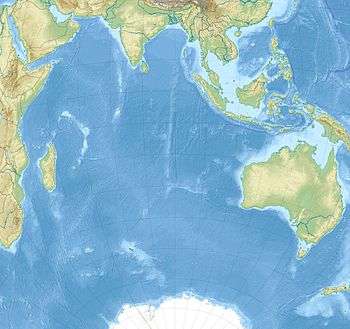Burckle Crater

Burckle Crater is an undersea feature hypothesized to be an impact crater by the Holocene Impact Working Group. They considered that it likely was formed by a very-large-scale and relatively recent (c. 3000–2800 BCE) comet or meteorite impact event. It is estimated to be about 30 km (18 mi) in diameter,[1] about 25 times wider than Arizona's Meteor Crater.
It is east of Madagascar and west of Western Australia in the southern Indian ocean adjacent to the SW Indian Ocean Ridge.[2] Its position was determined in 2006 by the same group using evidence of its existence from prehistoric chevron dune formations in Australia and Madagascar that allowed them to triangulate its location. But the theory that these chevron dunes are due to tsunamis has been challenged by geologists Jody Bourgeois and R. Weiss. Using a computer model to simulate a tsunami, they argue that the structures are more consistent with aeolian processes.[3] The tsunami's origin of these chevrons is also disputed by other Earth scientists.[4]
Burckle Crater is at 30°51′54″S 61°21′54″E / 30.865°S 61.365°ECoordinates: 30°51′54″S 61°21′54″E / 30.865°S 61.365°E in the Indian Ocean and is 12,500 feet (3,800 m) below the surface.
Formation
Burckle Crater has not yet been dated by radiometric analysis of its sediments. The Holocene Impact Working Group think that it was created about 5,000 years ago (c. 2800–3000 BCE) during the Holocene epoch when a comet impacted the ocean, and that enormous megatsunamis created the dune formations which later allowed the crater to be pin-pointed.
Unusual calcite (CaCO3) crystals, translucent carbon spherules, fragments of basaltic glass and native metals (native iron and nickel) are reported near the crater and associated with impact ejecta or hot water precipitates. Seawater at the depth of the crater is undersaturated with respect to calcite and rapid burial would be needed to preserve those crystals.[2]
See also
Notes
- ↑ Martos, S.N., H.D. Elkinton, E.F. Bryant, V. Gusiakov, and D. Breger (2006) Impact craters as sources of megatsunami generated chevron dunes. Geological Society of America Abstracts with Programs. 38(7):299
- 1 2 Abbott, D.H., P. Gerard-Little, S. Costa, and D. Breger (2009) Odd (CaCO3) from the Southwest Indian Ocean near Burckle Crater candidate; impact ejecta or hydrothermal precipitate? Abstracts of Papers Submitted to the Lunar and Planetary Science Conference. vol. 40, abstract 2243. Lunar and Planetary Science Conference : Houston, Texas.
- ↑ Bourgeois, J., and R. Weiss (2009) 'Chevrons' are not mega-tsunami deposits; a sedimentologic assessment. Geology. 37(5):403-406.
- ↑ Pinter, N., and S.E. Ishman, S.E. (2008). Impacts, mega-tsunami, and other extraordinary claims. GSA Today. 18(1):37.
External links
- Anonymous (2009) Past Tsunamis? Contrary To Recent Hypothesis, 'Chevrons' Are Not Evidence Of Megatsunamis. ScienceDaily, April 30, 2009.
- Blakeslee, S. (2006) Meteor 'misfits' find proof in sea Impacts more recent and often, researchers say. New York Times News Service, November 14, 2006.
- Colvin, M. (2006) Researchers claim link between tsunamis and outer space." ABC News, Australia (Transcript of ABC interview with Ted Bryant) November 14, 2006.

